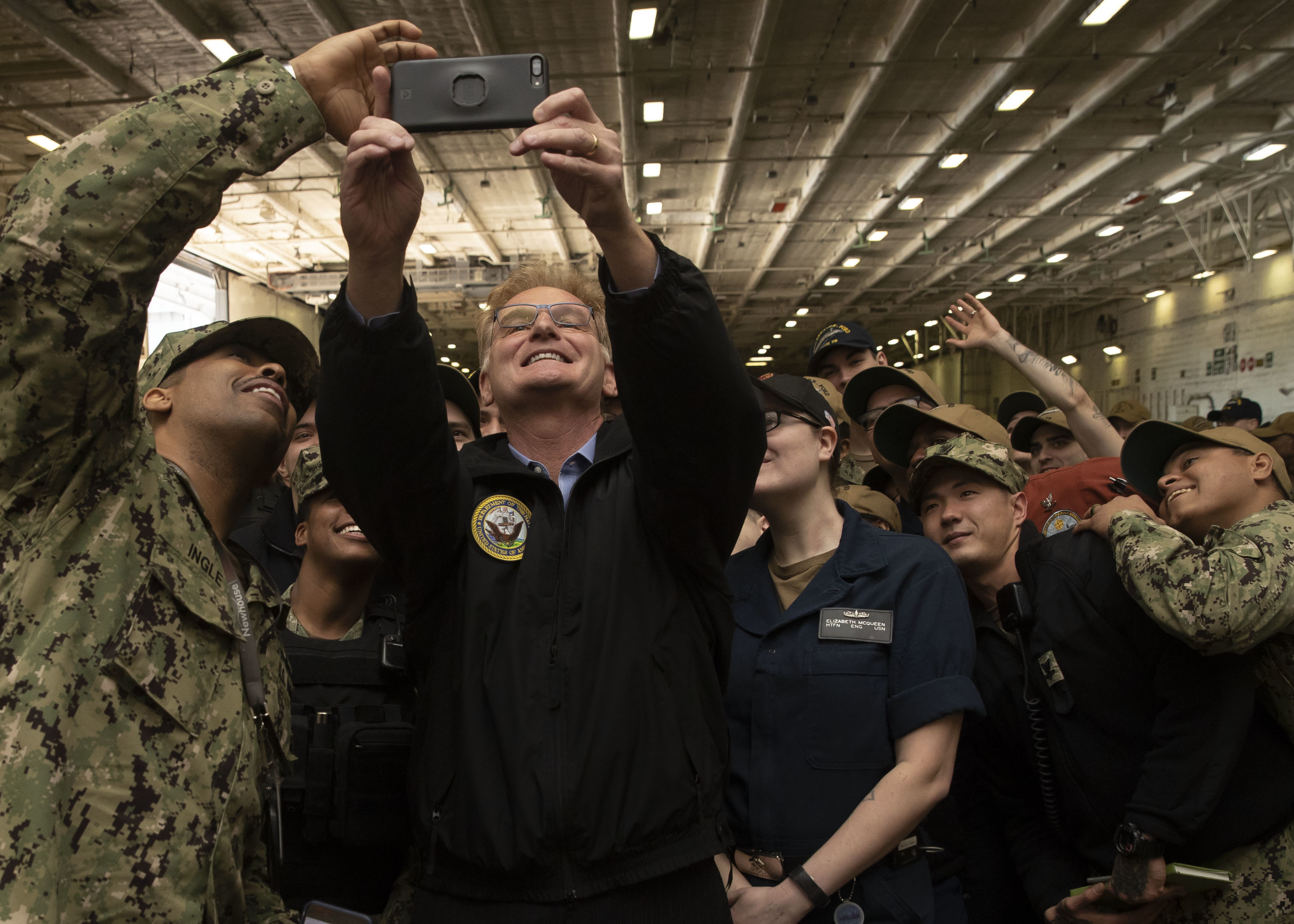
WASHINGTON, D.C. – A pending force structure analysis calls for bigger and more spread out Navy than previously thought, Acting Secretary of the Navy Thomas Modly on said Friday.
Following a day where lawmakers grilled Modly about the Navy’s yet-to-be submitted plan to field a 355-ship fleet, he described a recently completed – but not released – Integrated Force Structure Assessment during an appearance at the Brookings Institution. Modly’s broad-stroke details of the assessment painted a picture of a significantly larger, but more distributed, fleet to match capabilities with current and anticipated mission needs.
“I’m not sure 355 is the right number now,” Modly said. “The number is like 435 with unmanned in there. It’s 390 without unmanned in there.”
The Navy’s Integrated Force Structure Assessment had been expected to be released this past week ahead of Modly’s first appearances on Capitol Hill to answer lawmakers’ questions about the Fiscal Year 2021 budget request. However, Secretary of Defense Mark Esper, held the report for release while he seeks to square some differences between the Navy’s assessment and another assessment conducted by the Pentagon’s Cost Assessment and Program Evaluation (CAPE).
“CAPE did their own analysis,” Modly said. “There are some departures between CAPE’s plan and our plan. I don’t think they are that significant.”
On Wednesday, Esper was grilled by lawmakers during a House Armed Services Committee hearing about the lack of a long-range shipbuilding plan. On Friday, responding to criticism from lawmakers he was not listening to their concerns, Esper wrote a letter, obtained by USNI News, to the HASC leadership reaffirming his commitment to building a 355-ship Navy and echoing what Modly described as a core tenant of the upcoming Integrated Force Structure Assessment.
“The Department of Defense (DoD) remains committed to building a Navy of at least 355 ships. I personally believe the force structure required is even larger,” Esper wrote in his letter to Rep. Adam Smith (D-Wash.), the HASC chairman, and to Rep. Mac Thornberry (R-Texas) the HASC ranking member.
In the letter, Esper said he has assigned a senior leader review of the Navy’s plan.
Deputy Defense Secretary David Norquist has been assigned, “to take a fresh look at how we determine the composition of our future naval forces,” wrote Esper.
“The results of this rigorous analysis are due back to me this summer and will drive future shipbuilding plans. It is my intention to be transparent with you regarding the methods, progress and results of this assessment. This effort marks a unique opportunity to ensure that analysis on the fleet — the fleet that is needed to meet the [National Defense Strategy] — better drives our shipbuilding plan into the future.”
As for paying for the future fleet, Modly did not provide many details Friday or during his Thursday appearance before the HASC. Just funding a proposed 355-ship Navy is proving to be a monumental challenge. Modly told lawmakers if the Navy’s future budgets remain at the about the same level as they are now – $200 billion – then the Navy would need an additional $12 billion to $13 billion a year to reach 355 ships by 2030. The mix of those ships contained in the yet to be released shipbuilding plan and force assessment.
What is clear, based on Modly’s comments Friday at Brookings, is the force assessment completed by his department knocks down some long-held beliefs of fleet composition and the ideal fleet size, while creating a distributed force that can complicate an adversary’s calculations.
“Right now, the forces that we have, the ships that we have, do not necessarily support that end goal,” Modly said. “So that’s what we’re looking at how to invest.”
Large surface combatants are de-emphasized, Modly said, in favor of smaller, highly capable surface combatants such as the frigate and Littoral Combat Ship. The assessment focuses on the capabilities of the Navy and Marine Corps envision needing in future conflicts.
The Navy wants two new classes of ships – a small amphibious warship and a small surface support ship – to work with the Marine Corps for their evolving plans to focus on deploying more distributed forces.
“Currently, we don’t have either one of those types of ships in the fleet right now nor on the drawing board,” Modly said. “In this budget, the ’21 budget, we have dollars assigned to start.
Unmanned surface and undersea vehicles will be an essential part of the force structure, but Modly said the analysis places a premium on capabilities. Until the Navy proves the capabilities of unmanned vessels, Modly is reluctant to predict the size of an unmanned fleet.
The Navy is buying two large unmanned surface vessels to prove the technology and understand how it operates with other manned and unmanned vessels. More unmanned vessels will be planned as the Navy understands how to incorporate the platforms into its operations.
“The numbers at the end state of that are still in flux, and I’m clearly comfortable with that being in flux because frankly, we don’t have anything,” Modly said.
Large aircraft carriers remain part of the force assessment, Modly said. The Navy’s plan still pegs its future fleet to the idea of having 12 aircraft carriers. However, Modly noted at no point during the next 30 years does the Navy’s shipbuilding plan include having 12 carriers.
Last year’s two-carrier buy was critical by shaving an estimated $4 billion off the cost of building the third and fourth Ford-class carriers, Modly said. The $24 billion purchase also provides the Navy and Congress with some breathing room – at least six years before anyone needs to discuss the expense of buying another carrier.
“My personal opinion is I’m much less concerned about the survivability of the carrier from a warfighting perspective than I am about it from a fiscal perspective,” Modly said. “It’s really expensive, and we can only afford so many of these.”





